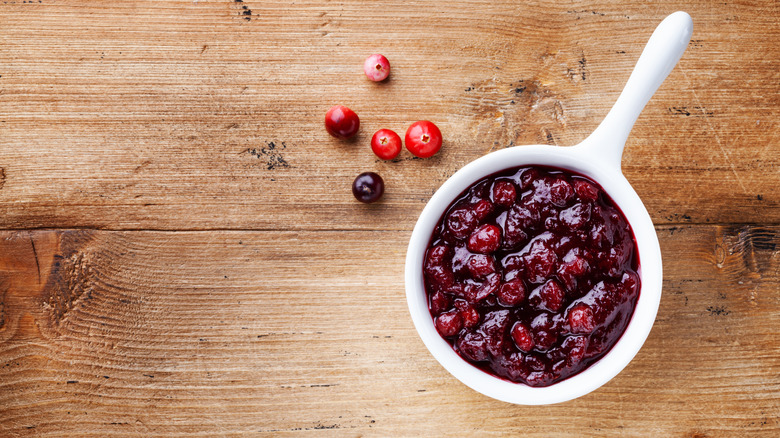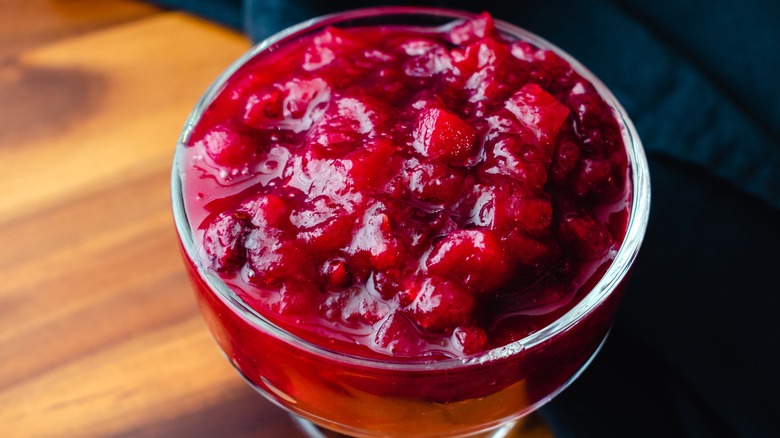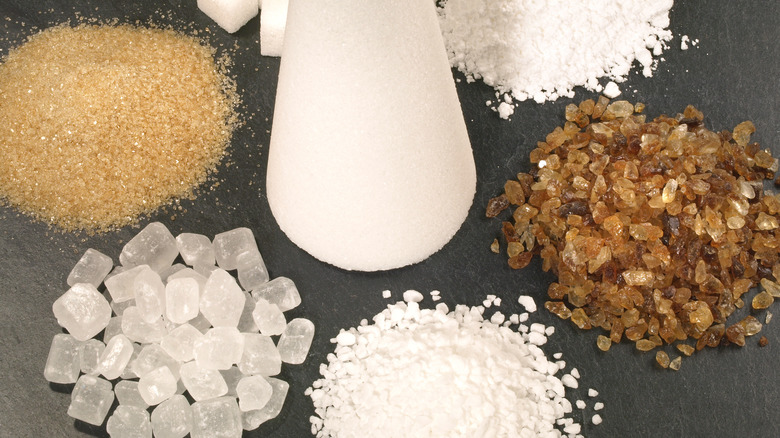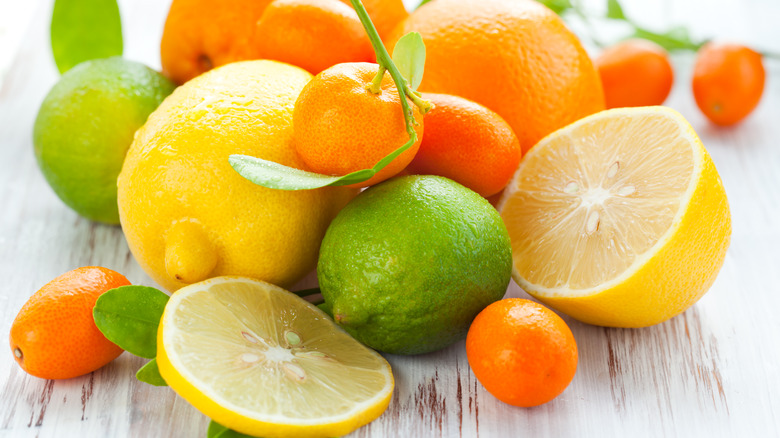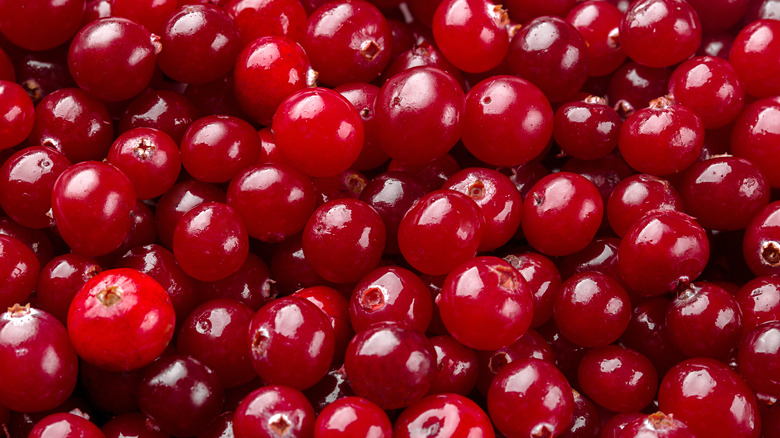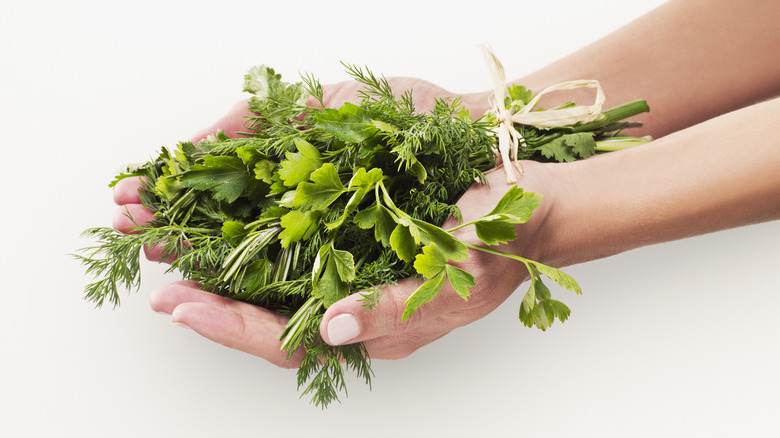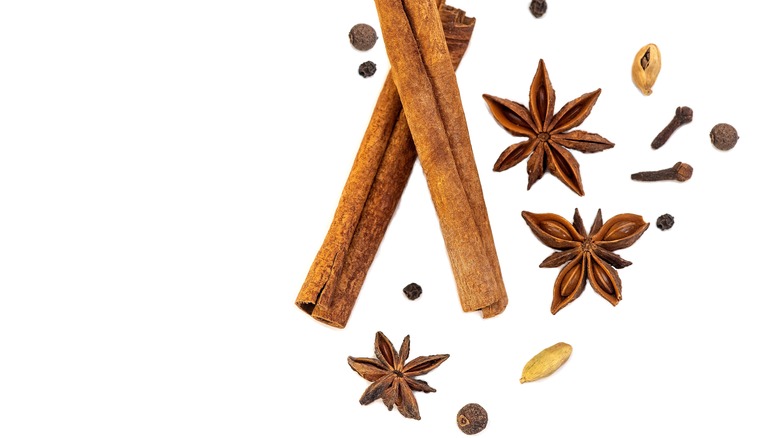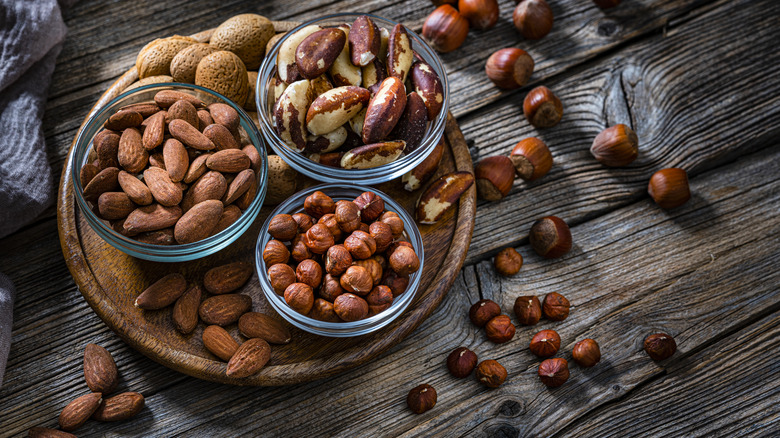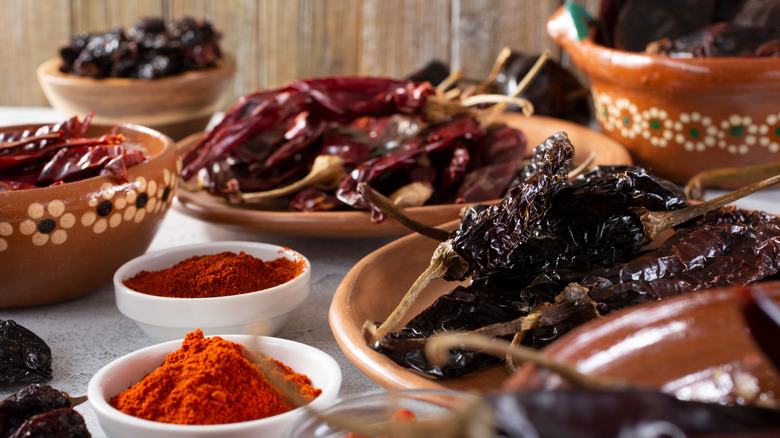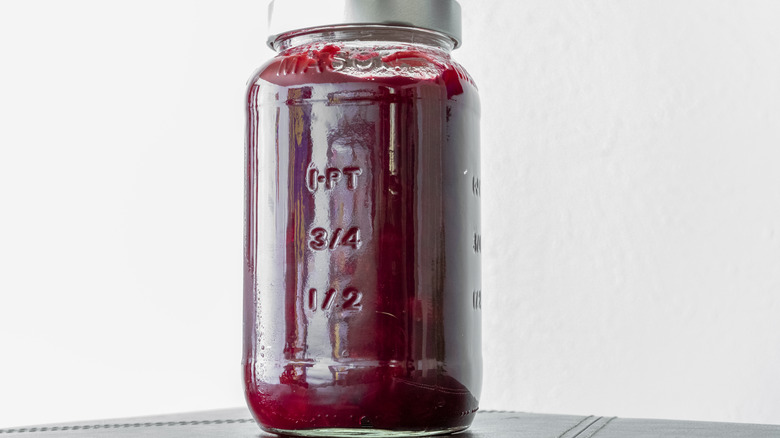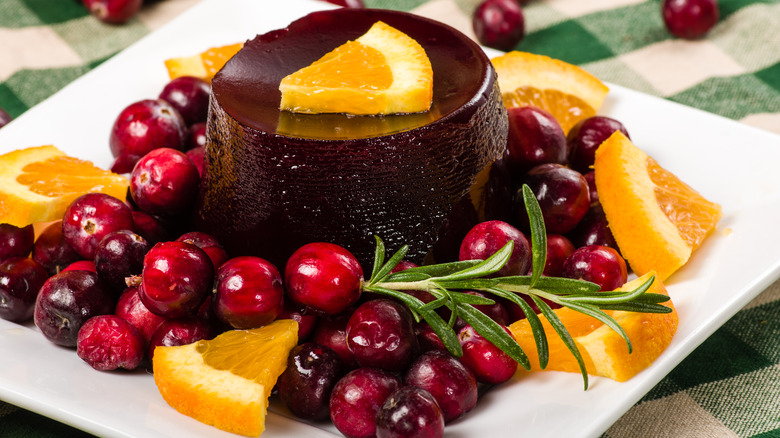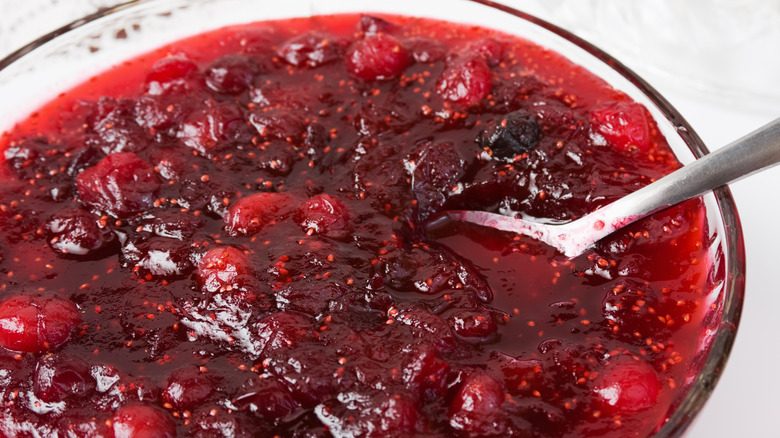13 Tips For Making Homemade Cranberry Sauce
Vastly better than canned sauce or jelly, and endlessly customizable, homemade cranberry sauce trumps store-bought at every turn. Not only does homemade cranberry sauce take minimal effort to make, but there are ways to make it shine for every set of taste buds.
Prepared canned cranberry sauce is available as a whole berry sauce or jelly. The whole-berry version is a lumpy concoction of cooked berries suspended in a syrupy-gelled sauce, while the jelly is firm, smooth, and sliceable. Both versions have only a handful of ingredients, but often feature high fructose corn syrup or citric acid. The result is a one-dimensional sauce that people either love or hate. Homemade cranberry sauce, on the other hand, can be as simple as two ingredients, or feature combinations of unique and delicious ingredients — with no corn syrup or citric acid required.
As a professional recipe developer (and devout cranberry lover), I've created dozens of cranberry sauces, and learned how adjustments to ingredients or cooking methods can impact the final result. If you think you don't like cranberry sauce, it's time to revisit this ruby-red berry. Here are 13 tips for making homemade cranberry sauce.
Control the thickness
The optimal thickness for cranberry sauce is a personal decision. Some want it super thick — so it can be piled onto a sandwich — while others prefer a thinner version that runs on the plate (and mingles with gravy). To control the thickness of the finished sauce, you should consider the volume of added liquid, cooking evaporation, and the pectin in cranberries.
Liquid and evaporation go hand in hand, so a higher ratio of liquid-to-fruit will equal a thinner sauce. If you start with more liquid than called for (or shave some time off when simmering the berries), then you'll end up with a looser flowing sauce. Pectin is another natural factor at play. As cranberries cook and open, pectin is released. This, combined with sugar, causes the sauce to gel — though keep in mind that more pectin is released the longer and more vigorously it cooks.
For any stubborn berries that won't split, lightly mash with a firm spatula once they've softened. Since you can't always tell what a cooled and chilled sauce will be like when it's hot, there's a common jam-making technique to use. Put a small plate in the freezer for at least 5 minutes. Next, drop a small spoonful of hot sauce on the plate, then return to the freezer briefly to instantly set the sauce. After you discover the sauce's final texture, continue cooking to thicken, or add some liquid to thin it out.
Modify the sweetness
The natural tartness of cranberries requires some sugar to make the sauce palatable enough to eat (and help the sauce set to the desired consistency). And while some recipes take the sweetness to a candy level, there's no need to make it that sugary if you don't want it to be. Of course, you can always reduce homemade cranberry sauce's sweetness by adding less sugar. But sugar is still essential to creating a gelled sauce, so do this conservatively if you want it to set.
Another way to modify sweetness without compromising texture is by considering what you can add (rather than take away). You can achieve greater tartness, for instance, by stirring in some whole or chopped uncooked cranberries after the sauce has finished. They'll soften slightly in the warm sauce, while retaining their raw punch.
Additionally, you can add sharpness with citrus, vinegar, or a combination of both. Adding these ingredients at the beginning can help balance the sauce, as the sharpness will mellow while cooking. You can also introduce citrus juices or vinegar at the end to add a little pucker — but be sure you select a type of vinegar that best complements the recipe.
Try new ways to sweeten
Granulated white sugar is the go-to sweetener for many recipes. But there are many other types of sugars that sweeten just as well (while adding a different flavor). Brown sugar, coconut sugar, and maple sugar all bring a caramel richness that pairs nicely with cranberries — especially when there's some warm spices, or a dash of vanilla extract. You can even use these sugars in combination with granulated sugar to make sure the sauce firms.
Beyond sugar, fruit juices and syrups can be used as cranberry sauce sweeteners. You can replace some water in a classic recipe with apple, cherry, or grape juice, and maple or agave syrup can be added, as well. Since these are liquid sugars, adding too much can make the sauce runny, so it's best to think of these as additions rather than replacements.
Jams, preserves, and marmalades, can also add a hit of flavor while sweetening; orange marmalade, for example, brings huge citrus flavor (and a little bitterness). Additionally, unlike fresh fruit (which releases excess water), fruit-based spreads are already concentrated — making it a way to enhance the flavor as well as a shortcut.
Spike it – with a light hand
A glug of red wine, brandy, or bourbon (among other alcohols) will bring a sophisticated twist to any homemade cranberry sauce, and nicely complement its other flavors ... if you add it in moderation. For starters, too much alcohol can add an unexpected (and unpleasant) sharpness or bitterness to your sauce. Given this, you won't want to use it as a substantial replacement for any actual water used in a recipe – and a few tablespoons should be enough to get the benefits without the drawbacks.
Secondly, since it takes time to cook alcohol out of a dish, it's essentially impossible to ensure the alcohol content will be sufficiently reduced in quick cooking recipes (like cranberry sauce). This means even a small amount of spirit in a full batch of cranberry sauce will likely retain a nominal amount of alcohol in the finished product — so it may be wise to consider any guests or kids at the table before including it in a recipe.
Showcase your citrus
Fresh lemon juice is a common addition to cranberry sauce recipes. Even though cranberries are naturally tart, adding citrus enhances the brightness of the fruit. And since cranberry season coincides with the start of the most abundant time of year for citrus, there's no need to stick exclusively with lemon juice.
Tangerines, blood oranges, grapefruits, and limes are a few options to consider. Each has its own unique flavor — and balance of acidity and sweetness — that can transform an otherwise straightforward sauce. You can also try mixing and matching a few different fruits in one sauce, like lemon-lime, or tangerine-blood orange (be sure to juice your lemon while keeping it fresh in the process).
Fresh citrus peels are another smart addition to homemade cranberry sauce. Citrus peels carry flavor differently than juice; the oils in the zest bring bitterness and floral notes, while the juice brings acidity and sweetness. For a mild citrus flavor, add some larger zest strips — removed with a vegetable peeler — while simmering, which can be discarded (or left in the finished sauce as a lightly candied treat). For a more intense flavor, you can finely grate the zest beforehand, then add it while the sauce simmers or cools — just remember the less it cooks, the sharper the flavor.
Keep it raw and fresh
One of the most eye-opening ways to make cranberry sauce involves no cooking at all. Often called cranberry relish, it's what pico de gallo is to a jar of salsa. Fresh, bright, and crunchy, start by pulsing cranberries — fresh or frozen – in a food processor with a little sugar (and a pinch of salt) until it's finely chopped.
From there, you can take it savory by adding finely chopped herbs, onion, and lime juice — like with salsa — or add some zing with your favorite spicy condiment, such as horseradish. To keep it on the sweeter side, just add more sugar, along with your choice of fresh ingredients — from chopped apples or pears, to dried fruits or nuts.
This method is also a great way to prepare cranberries for certain appetizers, as the freshness of the berries cuts through the richness of certain ingredients like cheese. You can make this type of sauce ahead of time, as well — because just like a cooked version, it only improves as the flavors sit and mingle together.
Use fresh herbs or chiles
Whether your palate skews savory, or you're a heat seeker, cranberry sauce can encompass either preference. For a hint of herbal (and savory) flavor, use whole-stemmed herbs to perfume the sauce. Similarly, you can poke a few slits into a whole chile — or halve it — then let it simmer with the cranberries. This is a great choice if you're using spicier chiles, as you'll get a good amount of flavor without the pepper's full, fiery blast. These pieces can be picked out before refrigerating or serving, as well, but remember: The longer they steep, the more flavor they'll release.
Chopping fresh herbs or chiles will impart a deeper flavor to the sauce. For heartier herbs, like rosemary, thyme, or sage, chop the leaves before, and let them cook with the sauce so they soften (while tempering the herb's strong flavor). On the other hand, tender herbs, such as parsley, mint, or cilantro, should only be stirred in before refrigerating or serving so they don't completely wilt (and lose their zest).
For chiles, take your cue from the size and heat level of the pepper. For a small one, like the Thai chile, thin rounds not only look lovely visually, but each slice will give a nice bite of heat. For a larger chili, like jalapeños or habaneros, chop it into smaller pieces so the heat disperses evenly — and no one blows out their taste buds.
Add some warming spices
Warm spices, such as cinnamon, cloves, and cardamom, embody the flavors of the holiday season. But in order to get the most flavor from these spices into your homemade cranberry sauce, there are a few things to know. Choosing whole spices over a container of pre-ground will add a much fuller flavor (which can be further intensified if to toast your spices first, as well). After cooling, crush or grind smaller spices, like peppercorns or cloves, in a mortar and pestle (or spice grinder), then add it to the sauce.
You can skip the step of crushing or grinding by choosing larger spices, though, such as cinnamon or star anise. These should still be toasted, but can be left whole in the sauce as they are easy to pick out. Additionally, to avoid grinding smaller spices, tie them in a piece of cheesecloth before cooking with the cranberries. This way, the bundle is easy to remove, and you can get the flavors into your sauce without worrying about any hard, little bits getting mixed in.
Give it some crunch
If the soft texture of cranberry sauce is an issue, you may want to add some crispy or crunchy elements. Nuts (roasted or otherwise), for example, can be stirred into a sauce while cooking, or sprinkled over the top as a garnish before serving. Of course, while adding nuts to a simmering sauce will infuse more flavor throughout the cooking process, they may also soften a little over time. For the biggest hit of texture, then, it may be best to add a generous amount of nuts as a topping after the sauce has finished cooking.
Another way to introduce texture into homemade cranberry sauce is with raw fruits or vegetables. For the best results, choose hearty produce that isn't likely to leach water into the finished sauce (sorry, zucchini, you're not invited to this party). Pomegranate arils are ideal, as they already have a natural shell holding the juice and seed inside.
While you can buy pomegranate arils from the store ready to go, these may have a sour flavor (or spoil quickly), so extracting arils from a fresh pomegranate is the better choice. Other good options include chopped apples, celery, or halved grapes. In each case, you'll want to avoid cooking (and softening) the ingredients, so stir them into the cooled sauce before refrigerating or serving.
Consider new flavors
Often relegated to citrus or Thanksgiving-centric flavors, cranberries are more versatile than one might think at first glance. Along those lines, if the flavor of cranberries alone isn't appealing to you, pairing them with slightly unexpected ingredients just may change your overall opinion regarding the taste of cranberry sauce.
You can play to the sharp acidity of the berry with equally bold flavors like fresh ginger. Tropical ingredients, on the other hand (including coconut and pineapple), can be buttery rich or sugary sweet — making the cranberry's tartness a welcome relief that cuts through either addition.
For an earthy (and less fruity) spin on your sauce, dried chiles bring everything from a smoky twist to a raisin-y depth. To bring out the full flavor of whichever dried chile you choose to use, though, be sure to discard the seeds before using it. You can also puree dried chilies with some liquid until they're smooth, and simmer with the fruit to integrate the flavor throughout.
Make it ahead
When you're tasked with preparing a big holiday meal, one way to ease the stress of entertaining is by factoring in recipes you can make in advance — and cranberry sauce is the perfect make-ahead recipe. It only gets better with time as the flavors mingle together, after all, and you can make it up to one week ahead if kept it in the refrigerator in a sealed container. While some suggest freezing prepared cranberry sauce, this can make the sauce watery, so it may not be your best option.
If you make cranberry sauce ahead of time, be sure to let it cool to room temperature before transferring it to a container and sealing it. Additionally, let it come to room temperature before serving — and give the sauce a good stir, as it will have settled and gelled while chilling. Of course, while this would be the time to make any final flavor adjustments by stirring in something fresh or adding a garnish, feel free to skip this step if you (or one of your guests) enjoys breaking the smooth surface of a sauce.
Make your own jelly – in any shape you want
It's easier than you think to make homemade jellied cranberry sauce – and, unlike Ocean Spray's iconic jellied cranberry sauce, your homemade version won't require a number of extra ingredients to become shelf-stable. You can still make it in a few hours, too, with just a few minor tweaks to the basic method (and ingredients) used for whole-berry cranberry sauce.
Compared to a whole-berry version, homemade jellied cranberry sauce requires a little extra sugar and boiling time. This ensures the mixture is thick (and gelled) enough to hold its shape. Next, you'll need to blend the berries, strain the mixture to remove the skins, then transfer the puree to whatever size or shape of molds or dishes desired. You can use a decorative mold to create a larger variety, or make mini, individually-sized jellies.
Once transferred, cover the jellied sauce by pressing plastic wrap against the surface (which prevents a skin from forming), and refrigerate until firm. Depending on the size of the jelly, this could happen quickly, or take a few hours. It will also hold overnight, though, so it's an ideal make-ahead dish. To serve, run a thin spatula around the side of the dish to break the seal of the jelly, or try dipping it in warm water like you would to get out a Jell-O mold.
Make a lot or a little
There are many excellent uses for Thanksgiving leftovers, including cranberry sauce. But if you'd rather not have leftovers — or your guest list just doubled — it's easy to adjust homemade cranberry sauce to make as little or as much as needed.
Now, when changing the yield of a recipe, it may be more helpful to follow visual cues, as opposed to going solely by time. A half-batch of cranberry sauce will come to a boil faster, after all, since there's less water to heat, so expect a decrease in the overall cooking time (even if it takes the same amount of time for the berries themselves to soften and pop).
Adjustments should also include the type of pot used. The same pot you'd use to make a regular-sized batch of cranberry sauce may still work when you double the recipe. But the greater volume will take longer to come to a boil and thicken to the right consistency. To speed thing up, try using a larger, wider pot when you increase the size of your cranberry sauce batch. Conversely, for a smaller batch, go down a pot size, so the water doesn't evaporate too quickly — and leave your sauce at risk of scorching.
Static Media owns and operates Tasting Table and Mashed.
